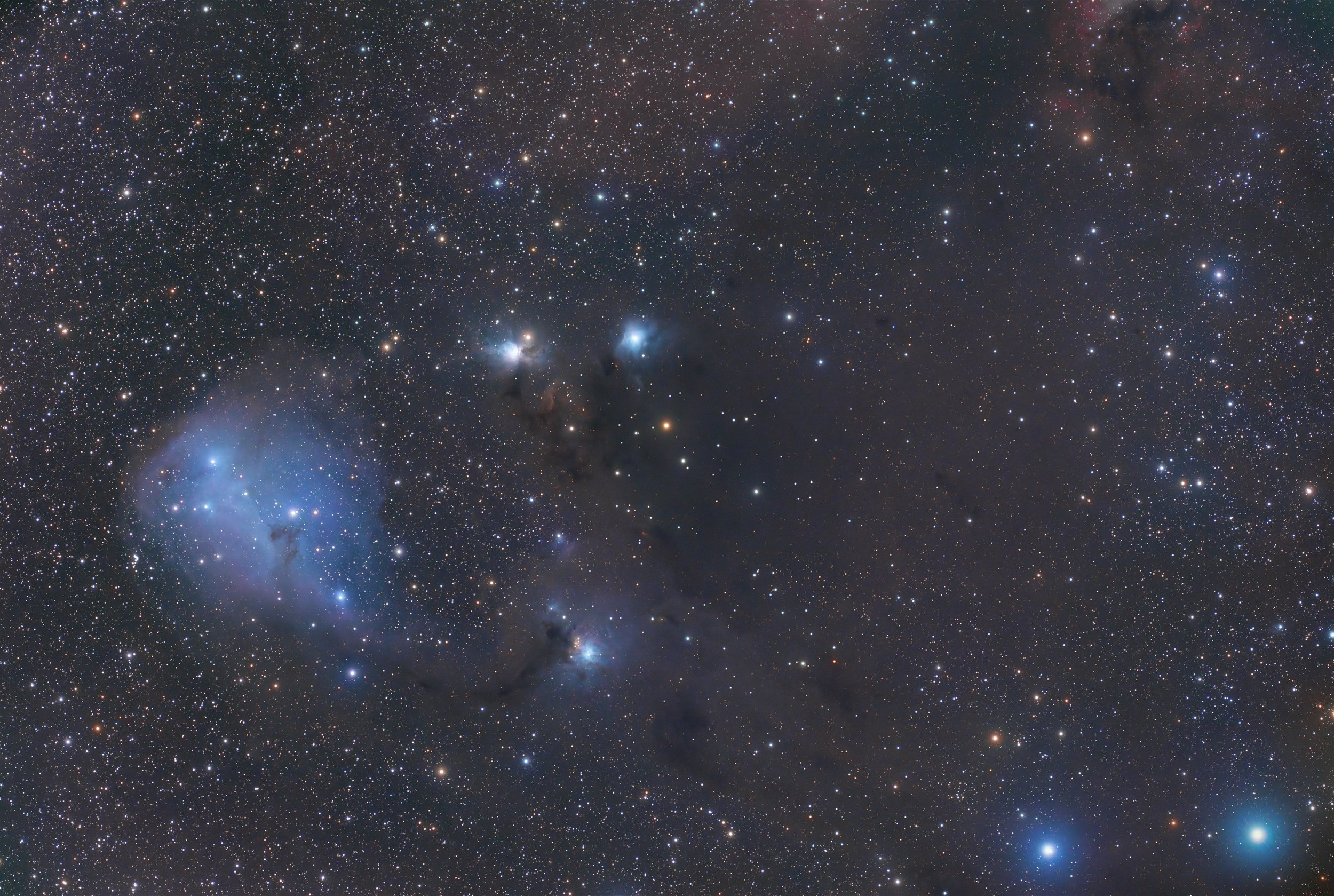
AAPOD2 Image Archives
WR134 and her friends (94 hours)
WR 134, a massive Wolf-Rayet star in the constellation Cygnus, anchors a dramatic cosmic scene surrounded by her "friends"—neighboring stars and intricate nebulae shaped by their stellar winds. This luminous blue star, approximately 6,000 light-years away, is in a late, short-lived phase of stellar evolution, shedding mass through intense winds at speeds exceeding 1,000 kilometers per second. The energetic interactions between these winds and the surrounding interstellar medium have sculpted a delicate bubble of ionized gas, glowing faintly in hydrogen-alpha light.
This stunning portrait of WR 134 and her companions was the result of a collaborative 94-hour imaging effort by four amateur astrophotographers. Working together with hydrogen-alpha and oxygen-III filters, they captured the faint structures surrounding WR 134, along with contributions from nearby Wolf-Rayet stars like WR 135 and WR 136. Their combined skill and dedication reveal the ephemeral beauty of massive stars near the end of their lives, enriching the cosmos with heavy elements and energy as they prepare for their ultimate fate as supernovae.
WR-134
WR 134 is a Wolf-Rayet star in Cygnus which is around 6,000 light years distant. It shines at 400,000 times the luminosity of the sun. Intense radiation and stellar winds have created a bubble of gas around the star. In this image the bubble is seen in blue/green doubly ionized oxygen (OIII) light. A large amount of hydrogen (HII) emission is also displayed as the red areas. The star responsible for this is near the center of the bubble and is whiteish. The image was taken with my #Stellarvue SVX 152T refractor and #zwoasi 6200 camera through RGB and HII/OIII filters. The image combines a bit over 47 hours of exposure time. Automation was controlled with a #primalucelab Eagle 4 pro and Voyager Astrophotography Automation software. The image is cropped and rotated for a pleasing view.
COPYRIGHT: Jon Talbot
WR 134 - V1769 Cyg
This colorful shot covers a field of view about the size of the full Moon within the boundaries of the constellation Cygnus. It highlights the bright edge of a ring-like nebula traced by the glow of ionized hydrogen and oxygen gas. Embedded in the region's interstellar clouds of gas and dust, the complex, glowing arcs are sections of bubbles or shells of material swept up by the wind from Wolf-Rayet star WR 134, brightest star near the center of the frame. Distance estimates put WR 134 about 6,000 light-years away. Shedding their outer envelopes in powerful stellar winds, massive Wolf-Rayet stars have burned through their nuclear fuel at a prodigious rate and end this final phase of massive star evolution in a spectacular supernova explosion. The stellar winds and final supernovae enrich the interstellar material with heavy elements to be incorporated in future generations of stars.
Tech card:
Imaging telescope: Explore Scientific 127mm ED TRIPLET APO.
Imaging camera: ZWO ASI1600MM Pro-Cool.
Mount: iOptron CEM60.
Guiding camera: ZWO ASI290MM mini.
Focal reducer: Explore Scientific 0.7 Reducer/Flattener.
Accessory: ZWO EAF Electronic Auto Focuser · ZWO ASIAIR Pro · ZWO OAG · ZWO 8x 1.25" Filter Wheel (EFW).
Frames:
Chroma 3nm Ha: 10x600" (gain: 200.00) -20C bin 1x1.
Chroma 3nm OIII: 22x600" (gain: 200.00) -20C bin 1x1.
Total integration: 5.3 hours.
Darks: ~30.
Flats: ~30.
Flat darks: ~60.
Avg. Moon age: 18.13 days.
Avg. Moon phase: 87.56%
Bortle Dark-Sky Scale: 4.00.
Temperature: 20.00.
Pixel scale: 1.159 arcsec/pixel.
Imaging location: Abu Dhabi desert, UAE.
A re-process of my data of Dec. 3 and 4, 2020.
I tried to boost the OIII channel and tried to pull out some more details.
Copyright: Wissam Ayoub
WR134 - Full Shell
EQUIPMENT DATA:
Telescope: Borg 101ED f/4
Mount: Skywatcher HEQ5 (Rowan Belt Mod)
Camera: QHYCCD 163M
Filters: Optolong HORGB + IDAS LPS-P2 + WO VR1
Guide Scope: DIY Guidescope 43mm f/3
Guide Camera: QHY 5R-II
ADQUISITION DATA:
Location: Castillo de Villamalefa & Barcelona
Date: Summer 2019
Resolution: 1.87″/pixel
Guiding Performance: 1” RMS (average)
Exposures: (Gain 174 / Offset 77 / Bin 1×1)
H: 7.5h (91x300s)
O: 26.5h (319x300s)
R: 2.5h (81x120s)
G: 2.5h ( 81x120s )
B: 2h ( 66x120s )
Sensor Temperature: -10C
50 Flats (From Library)
50 Darks (From Library)
No Bias
Total Integration Time: 41h
Copyright: Alberto Ibañez





